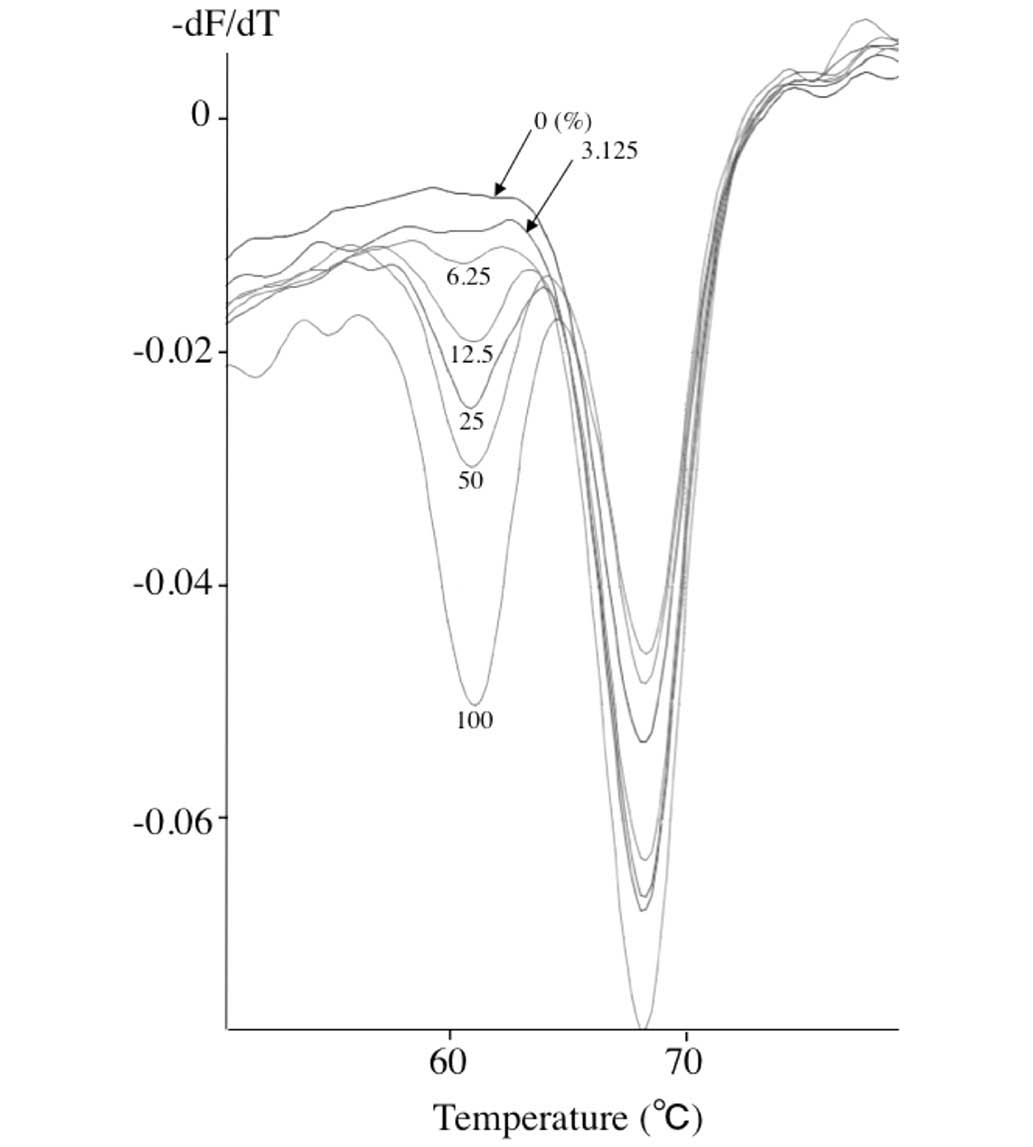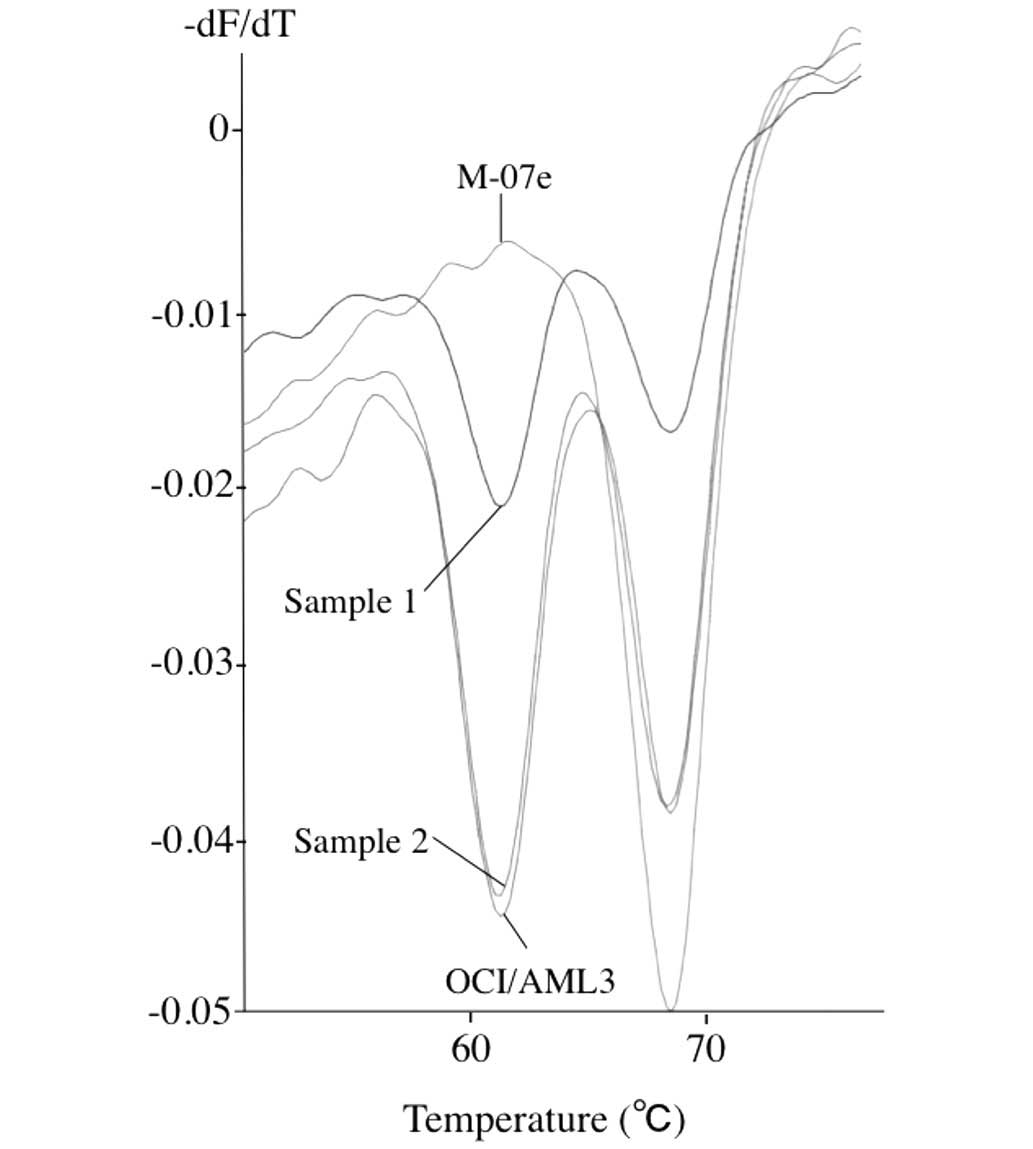|
1
|
Falini B, Mecucci C, Tiacci E, Alcalay M,
Rosati R, Pasqualucci L, La Starza R, Diverio D, Colombo E,
Santucci A, et al: Cytoplasmic nucleophosmin in acute myelogenous
leukemia with a normal karyotype. N Engl J Med. 352:254–266. 2005.
View Article : Google Scholar : PubMed/NCBI
|
|
2
|
Rau R and Brown P: Nucleophosmin
(NPM1) mutations in adult and childhood acute myeloid
leukaemia: Towards definition of a new leukaemia entity. Hematol
Oncol. 27:171–181. 2009. View
Article : Google Scholar : PubMed/NCBI
|
|
3
|
Arber DA, Vardiman JW, Brunning RD, Porwit
A, Le Beau MM, Thiele J, Falni B and Bloomfield CD: Acute myeloid
leukaemia with recurrent genetic abnormalities. WHO classification
of tumours of haematopoietic and lymphoid tissues. Swerdlow SH,
Campo E, Harris NL, Jaffe ES, Pileri SA, Stein H, Thiele J and
Vardiman JW: 2:(4th). (Lyon). IARC Press. 110–123. 2008.
|
|
4
|
Pianta A, Fabbro D, Damiani D, Tiribelli
M, Fanin R, Franzoni A, Romanello M, Tell G, Di Loreto C and
Damante G: Two novel NPM1 mutations in a therapy-responder AML
patient. Hematol Oncol. 28:151–155. 2010.PubMed/NCBI
|
|
5
|
Park SH, Chi HS, Shim H, Jang S and Park
CJ: Two novel NPM1 mutations in an acute myeloid leukemia
patient transformed from primary myelofibrosis. Int J Lab Hematol.
35:e1–e3. 2013. View Article : Google Scholar : PubMed/NCBI
|
|
6
|
Jeon Y, Seo SW, Park S, Park S, Kim SY, Ra
EK, Park SS and Seong MW: Identification of two novel NPM1
mutations in patients with acute myeloid leukemia. Ann Lab Med.
33:60–64. 2013. View Article : Google Scholar : PubMed/NCBI
|
|
7
|
Ahmad F, Mandava S and Das BR: Mutations
of NPM1 gene in de novo acute myeloid leukaemia:
Determination of incidence, distribution pattern and identification
of two novel mutations in Indian population. Hematol Oncol.
27:90–97. 2009. View
Article : Google Scholar : PubMed/NCBI
|
|
8
|
Falini B, Nicoletti I, Martelli MF and
Mecucci C: Acute myeloid leukemia carrying cytoplasmic/mutated
nucleophosmin (NPMc+ AML): Biologic and clinical features. Blood.
109:874–885. 2007. View Article : Google Scholar : PubMed/NCBI
|
|
9
|
Quentmeier H, Martelli MP, Dirks WG, Bolli
N, Liso A, Macleod RA, Nicoletti I, Mannucci R, Pucciarini A,
Bigerna B, et al: Cell line OCI/AML3 bears exon-12 NPM gene
mutation-A and cytoplasmic expression of nucleophosmin. Leukemia.
19:1760–1767. 2005. View Article : Google Scholar : PubMed/NCBI
|
|
10
|
Thiede C, Creutzig E, Illmer T, Schaich M,
Heise V, Ehninger G and Landt O: Rapid and sensitive typing of
NPM1 mutations using LNA-mediated PCR clamping. Leukemia.
20:1897–1899. 2006. View Article : Google Scholar : PubMed/NCBI
|
|
11
|
Oppliger Leibundgut E, Porret NA, Bienz
Muggli M, Baumgartner H, Dahlhaus M and Baerlocher GM: Rapid and
highly specific screening for NPM1 mutations in acute
myeloid leukemia. Ann Hematol. 92:173–177. 2013. View Article : Google Scholar : PubMed/NCBI
|
|
12
|
Scholl S, Mügge LO, Landt O, Loncarevic
IF, Kunert C, Clement JH and Höffken K: Rapid screening and
sensitive detection of NPM1 (nucleophosmin) exon 12 mutations in
acute myeloid leukaemia. Leuk Res. 31:1205–1211. 2007. View Article : Google Scholar : PubMed/NCBI
|
|
13
|
Tan AY, Westerman DA, Carney DA, Seymour
JF, Juneja S and Dobrovic A: Detection of NPM1 exon 12 mutations
and FLT3-internal tandem duplications by high resolution melting
analysis in normal karyotype acute myeloid leukemia. J Hematol
Oncol. 1:102008. View Article : Google Scholar : PubMed/NCBI
|
|
14
|
Laughlin TS, Becker MW, Liesveld JL,
Mulford DA, Abboud CN, Brown P and Rothberg PG: Rapid method for
detection of mutations in the nucleophosmin gene in acute myeloid
leukemia. J Mol Diagn. 10:338–345. 2008. View Article : Google Scholar : PubMed/NCBI
|
|
15
|
Noguera NI, Ammatuna E, Zangrilli D,
Lavorgna S, Divona M, Buccisano F, Amadori S, Mecucci C, Falini B
and Lo-Coco F: Simultaneous detection of NPM1 and FLT3-ITD
mutations by capillary electrophoresis in acute myeloid leukemia.
Leukemia. 19:1479–1482. 2005. View Article : Google Scholar : PubMed/NCBI
|
|
16
|
Ottone T, Ammatuna E, Lavorgna S, Noguera
NI, Buccisano F, Venditti A, Giannì L, Postorino M, Federici G,
Amadori S and Lo-Coco F: An allele-specific RT-PCR assay to detect
type A mutation of the nucleophosmin-1 gene in acute myeloid
leukemia. J Mol Diagn. 10:212–216. 2008. View Article : Google Scholar : PubMed/NCBI
|
|
17
|
Tanaka R, Kuroda J, Stevenson W, Ashihara
E, Ishikawa T, Taki T, Kobayashi Y, Kamitsuji Y, Kawata E, Takeuchi
M, et al: Fully automated and super-rapid system for the detection
of JAK2V617F mutation. Leuk Res. 32:1462–1467. 2008. View Article : Google Scholar : PubMed/NCBI
|
|
18
|
Ono A, Okuhashi Y, Takahashi Y, Itoh M,
Nara N and Tohda S: Advantages of the quenching probe method over
other PCR-based methods for detection of the JAK2 V617F
mutation. Oncol Lett. 4:205–208. 2012.PubMed/NCBI
|
|
19
|
Kurata S, Kanagawa T, Yamada K, Torimura
M, Yokomaku T, Kamagata Y and Kurane R: Fluorescent quenching-based
quantitative detection of specific DNA/RNA using a BODIPY((R))
FL-labeled probe or primer. Nucleic Acids Res. 29:E342001.
View Article : Google Scholar : PubMed/NCBI
|
|
20
|
Rothberg PG, Ramirez-Montealegre D,
Frazier SD and Pearce DA: Homogeneous polymerase chain reaction
nucleobase quenching assay to detect the 1-kbp deletion in CLN3
that causes Batten disease. J Mol Diagn. 6:260–263. 2004.
View Article : Google Scholar : PubMed/NCBI
|













